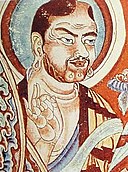Central_Asian_Buddhist_Monks.jpeg (470 × 591 pixels, file size: 173 KB, MIME type: image/jpeg)
File history
Click on a date/time to view the file as it appeared at that time.
| Date/Time | Thumbnail | Dimensions | User | Comment | |
|---|---|---|---|---|---|
| current | 12:25, 27 March 2005 |  | 470 × 591 (173 KB) | <bdi>Beta m common</bdi> | 9th century fresco from Bezeklilk, Tarim Basin. {{PD-art}} |
File usage
The following pages on the English Wikipedia use this file (pages on other projects are not listed):
- Albert von Le Coq
- Bezeklik Caves
- Bodhidharma
- Buddhism in Central Asia
- Central Asian art
- Dharmaguptaka
- Europeans in Medieval China
- German Turfan expeditions
- Greco-Buddhism
- History of Buddhism
- History of Chinese Buddhism
- History of Indian influence on Southeast Asia
- History of Xinjiang
- Kasaya (clothing)
- Missionary
- Post-classical history
- Religious habit
- Silk Road
- Silk Road transmission of Buddhism
- Tang dynasty art
- Tarim Basin
- Theodor Bartus
- Uyghurs
- Ānanda
Global file usage
The following other wikis use this file:
- Usage on ar.wikipedia.org
- Usage on ast.wikipedia.org
- Usage on az.wikipedia.org
- Usage on ba.wikipedia.org
- Usage on bg.wikipedia.org
- Usage on bjn.wikipedia.org
- Usage on bn.wikipedia.org
- Usage on bs.wikipedia.org
- Usage on bxr.wikipedia.org
- Usage on ca.wikipedia.org
- Usage on cs.wikipedia.org
- Usage on cv.wikipedia.org
- Usage on da.wikipedia.org
- Usage on de.wikipedia.org
- Usage on de.wikivoyage.org
- Usage on el.wikipedia.org
- Usage on en.wikiquote.org
- Usage on en.wikivoyage.org
- Usage on eo.wikipedia.org
- Usage on es.wikipedia.org
View more global usage of this file.

![A Caucasian Central Asian monk, possibly an Indo-European Sogdian or Tocharian, teaching an East Asian monk, perhaps a Turkic Uyghur or Chinese, on a 9th-century AD fresco from the Bezeklik Thousand Buddha Caves near Turfan, Xinjiang, China. A detail from Praņidhi scene no. 5 in Temple no. 9. The book that this painting is reproduced in has full descriptions of these two figures. Relevant details, along with the German descriptions, are found below. The figure on the right is a young Buddhist monk painted in a stereotypical East Asian style. He stands with downcast eyes directed in reverence as he hears the teachings of the figure on the left. The figure on the left is painted in a style that is not East Asian in character. The two circles on either side of his chin are remarkably unusual (piercings?). He features a strongly-set nose and clear blue eyes. His skin color is darker. His hair and beard color is reddish brown with brown shades. He stands looking at the younger monk, raising his hand in a teaching gesture as he speaks. Figure on Right: Über den Schirmen erheben sich die Gestalten zweier Mönche. Der rechts stehende ist ein Jüngling mit schablonenhaft gemaltem Gesicht ostasiatischen Typs; er trägt mehrere verschiedenartig gefärbte Unterkleider und daruber einen grünen, rot gestreiften Flickenrock. Er steht mit niedergeschlagenen Augen nach links gewendet in anbetender Stellung da und scheint andächtig den erklärenden Worten zu lauschen, die sein Begleiter an ihn richtet. Figure on Left: Dieser, ein alterer Mann im gelb und braunen Flickenrock, besitzt wiederum einen der auffallenden, nicht schablonenhalf gemalten Köpfe, die einen nichtostasiatischen Typus tragen. Er hat rotes Haar und einen roten Bart, dessen Stoppeln in einer sonderbar stilisierten Malweise wiedergegeben werden (man beachte auch die auffälligen nackten Stellen, die rechts und links von der Mitte des Kinnes erscheinen!). Seine Nase ist stark und hervorspringend; die geradestehenden Augen von klarer, blauer Farbe; die Hautfarbe ist rötlichbraun mit braunen Schattierungen. Er steht, den Blick auf seinen jüngeren Begleiter gewendet, mit erhobener Hand lehrend oder erklärend da. In "Tafel 19" of his Chotscho: Facsimile Reproduction of Important Findings of the First Royal Prussian Expedition to Turfan in East Turkistan] (Berlin, 1913), Albert von le Coq identified the figure on the right as a "Tocharer" (i.e. Tocharian) and the figure on the left as "Ostasiate" (i.e. East Asian). In other murals of the Bezeklik Budda Caves, however, foreign-looking Caucasian men have been identified as ethnic Sogdians (an Eastern Iranian people). For instance, Scene No. 6 in Temple 9, in the same temple as the aforesaid mural, modern scholars have identified the kneeling men draped in silk robes as Sogdians (see Gasparini, Mariachiara. "A Mathematic Expression of Art: Sino-Iranian and Uighur Textile Interactions and the Turfan Textile Collection in Berlin," in Rudolf G. Wagner and Monica Juneja (eds), Transcultural Studies, Ruprecht-Karls Universität Heidelberg, No 1 (2014), pp 134-163. ISSN: 2191-6411. See also endnote #32 for further information on source material.)](http://upload.wikimedia.org/wikipedia/commons/b/b8/Central_Asian_Buddhist_Monks.jpeg)
